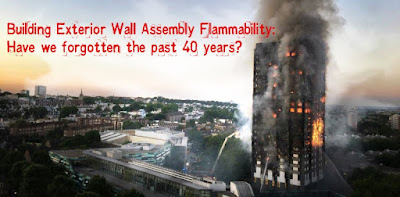The June 14 fire at London’s Grenfell Tower
apartment complex burned through 24 floors and claimed seventy-nine lives. The
rapid spread and magnitude of this incident can be attributed to the
combustible cladding used in the exterior construction of the tower.
The implementation and adoption of NFPA 285, Standard Fire Test Method for Evaluation ofthe Propagation Characteristics of Exterior Non-Load-Bearing Wall AssembliesContaining Combustible Components, has largely prevented these fire
incidents from occurring in the United States. This
standard outlines the requirements and test procedures to determine if a given
wall assembly could support a self-accelerating or self-spreading fire up an
exterior wall, or spread fire to interior floors above the fire floor.
Any materials intended for use as an
exterior wall assembly must pass the NFPA 285 test. The assembly will be
considered to have failed if:
- A temperature greater than 1,000°F at 10’ or higher above the top of the window opening, as measured by thermocouples mounted on the surface of the test specimen.
- Flames visually observed on the exterior face of the specimen at 10’ of higher above the top of the window opening.
- Flames visually observed on the exterior face of the specimen at 5’ or further from the centerline of the window opening.
- Temperature rise greater than 750°F within any combustible wall components more than ¼” thick.
- Temperatures greater than 1000°F within any wall cavity air space.
- Temperature rise greater than 500°F in the second story room, measured 1” from the interior surface of the wall assembly.
- Flames visually observed within the second-story test room.
By examining exterior wall fires around the
world, understanding the history and development of NFPA 285,
and reviewing the test method, Building Exterior Wall
Assembly Flammability: Have We Forgotten the Past 40 Years?,
demonstrates how the
continued use and enforcement of NFPA 285 is essential in preserving a fire
safe America.

